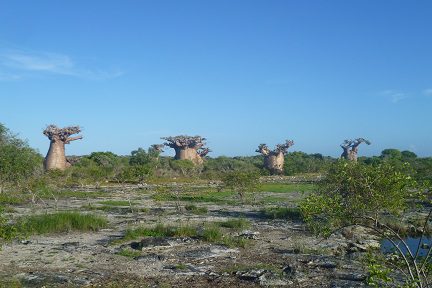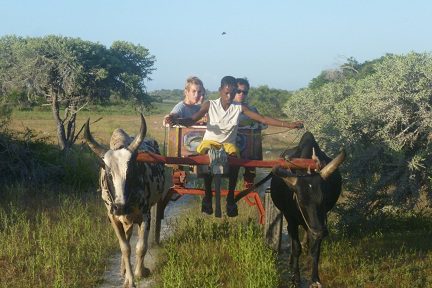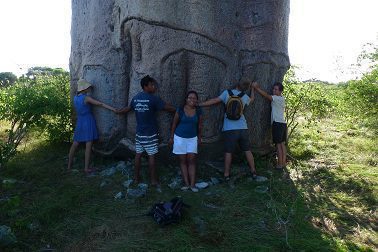by Madison Kane, Expedition Manager, Madagascar
Anywhere you go you’ll see trees; from palms in the Caribbean to snowy pines in Canada,from redwoods in California to eucalyptus in Australia. You name it, they’re all over. However, never had I seen such an incredible and out-of-the-ordinary kind of tree until I saw the legendary baobabs of Madagascar.
As the volunteers set out on the ‘journey of a lifetime’ and make their way across Madagascar on the pre-expedition overland tour, they will see many firsts – incredible rock formations, amazing landscapes, lemurs, varieties of captivating skills and talents, and of course the famous baobabs.
One’s reaction to these often shockingly massive phenomenons often consists of something like ‘whoa, look at the size of that tree!’ or ‘that is so cool, what is it?’ followed by the immediate need to grab a camera and take photos of the fattest, tallest tree they’ve ever see in their lives. It was for me, at least.

The baobab forest near Andava
The baobab genus (or Adansonia in latin) is also called ‘boab’, ‘upside-down tree’, or ‘monkey bread tree’ consists of nine species, six of which are indigenous to Madagascar (two are native to mainland Africa and one to Australia!). Their name in Malagasy, ‘renala’, means forest mother and whilst living on-site in Andavadoaka, I always jump on the opportunity to venture out during sunrise on a rickety wooden cart pulled by Zebu to see this imposing and unusual tree up close – and is an absolute expedition must do for all our volunteers. There is a forest full of a species called Grandidier’s baobab (Adansonia grandidieri), which is endemic to SW Madagascar, just seven kilometres away from what volunteers will call ‘home’ for six weeks.
Grandidier’s baobab is the largest and most famous of Madagascar’s baobabs, and from experience, an unforgettable expedition day will be your visit to the baobab forest outside Andavadoaka. After rising before the sun, which many villagers do here, you will meet up with Jacks, Blue Ventures’ Volunteer Liaison and your personal baobab tour guide, for a journey in a colourful wooden cart hitched to two zebus. Still half asleep, you’ll head to the local coffee shop and grab some coffee and a legendary breakfast of ‘boko boko’ (deep fried donut-like dough balls) to take on the road. As you travel into the sunrise, waking up at an hour much earlier than normal won’t seem half bad. Off on the horizon, you can see these structures that all travel books call a ‘must see’ and knowing you’re headed much closer than your previous out-the-car-window view is thrilling. As you arrive next to a forest of massive cylindrical trunks, you will hop out of the zebu cart and try to give it a hug realizing you can’t nearly match their wide girth, nor can you see twenty metres up to their branching tops.

Zebu cart – the only way to travel!
Trees have characters, and so over the years our volunteers have named the various baobabs; you will see the ‘elephant baobab’, ‘Bob Marley’ and one with a perfect read-made opening, which is a perfect place for eating breakfast. During what most would call ‘spring’ back home (April-July), the flat-topped crowns bear palmate leaves and spectacular flowers with white petals. In the winter months (November-January), these trees bear large, dry fruits, which you can purchase in the village and from which you can make a delicious juice.
Andavadoaka, and the SW, has quite a harsh, dry climate compared to the rest of Madagascar, but baobabs have the ability to store large amounts of water within them to endure the harsh drought conditions. These trees, with their incredibly swollen trunks, can hold up to 120,000 litres of water! Unfortunately though such an astonishing plant and absolute must see for tourists and nature lovers, Grandidier’s baobab was classified as endangered by the IUCN Red List in 2006. Their seeds are rich in Vitamin-C (possibly more than oranges), leaves are sold as vegetables throughout mainland Africa and their thick bark and long, tough fibres are used for various sorts of building. Since their population is declining, consider yourself lucky to witness the beauty of the baobab forest.

Even in a human chain you can’t always reach all the round these forest giants
After wandering throughout the forest, eating a breakfast that mom would never approve of, and filling your memory card with photos, you’ll head back to site. Jacks will give you the chance to drive the zebu cart, which isn’t nearly as easy as it looks but is definitely worth the challenge. If the season is right, normally just after the rains (March – May), it’s worth taking a detour home, past the salt ponds where you may lucky enough to see beautiful pink flamingos bathing in the water. Enjoy the journey home because as you arrive back at site, you’ll have a peek at your watch and realize its only 10am. Already completely satisfied, you’ll think, what’s next for the day??

